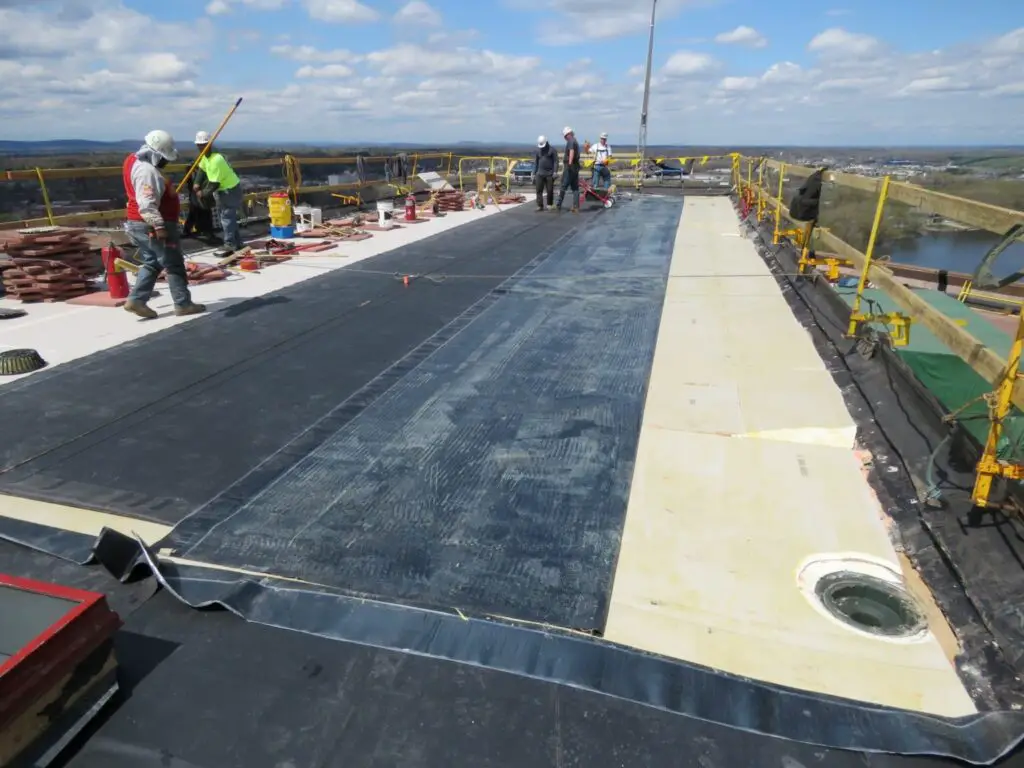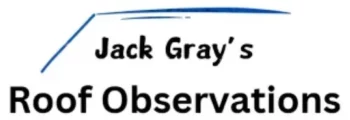I participate in the Amazon affiliate program and may earn commissions from purchases made through links on this page.
Table of Contents

Introduction
In this article, I’m going to explain the factors that determine EPDM roof costs. I’ll also give you the typical costs for various types of EPDM rubber membrane roofs in 2025.
Roof consultants typically have to produce accurate roof replacement budget projections for their clients every year. This means keeping up-to-date with changing material and labor costs for all kinds of roofing, including EPDM rubber roof systems.
I’ve prepared budgets and/or overseen the bidding process for many, many EPDM roof replacements over the years.
Keep in mind that the cost of any particular EPDM rubber roof will depend on several variables, including roof size, roof complexity, local labor costs, membrane thickness, roof system attachment method, and insulation R-value requirements. For low-slope (flat) roofs, insulation is typically an integral part of the roof system, so insulation costs are a big part of the total cost of a commercial roofing project.
Whether or not a roof recover (putting the new roof over the old roof) is an option for your roof can have a huge effect on the cost of a roof replacement job.
On average, the cost of a new EPDM rubber roof in 2025 ranges from $4.20 per square foot for a 45-mil ballasted EPDM system installed over an existing roof to $14.25 per square foot for the top-of-the-line EPDM roof system, a fully-adhered 90-mil EPDM membrane system (with above-deck R-30 insulation).
What is EPDM Roofing?
EPDM, an acronym for “ethylene propylene diene monomer,” is a synthetic rubber that offers exceptional durability, waterproofing capabilities, elastomeric properties, and high flexibility. These qualities make it an excellent choice for single-ply roofing applications. “EPDM roofing” refers to low-slope or “flat” roof systems where sheets of EPDM rubber are joined together to create a reliable, watertight roof membrane.
Typical components of a full EPDM roof assembly include the roof deck, which provides structural support, an air or vapor barrier to prevent moisture from migrating into the roof system (if needed), layers of rigid board insulation to provide thermal efficiency for the building, and a cover board over the insulation and underneath the membrane (as specified by the manufacturer). The EPDM membrane itself, along with attachment components such as adhesives, fasteners, or ballast, completes the system.
Originally developed in the 1950s, EPDM became widely used as a roofing material in the 1960s. By the 1980s, it was the dominant material in the single-ply roofing market. Its chief competitors today are PVC membrane and TPO membrane roofing.
While EPDM remains popular in northern regions, it has lost significant market share in warmer climates. This is primarily due to the increasing use of reflective white membranes like TPO, driven by energy code and LEED requirements demanding “cool roof” systems with reflective white roof membranes.
Overall, EPDM has a history of remarkable performance and longevity in the roofing industry.
EPDM Rubber Roof Cost in 2025
These cost estimates should be fairly accurate; I try to keep them reasonably up-to-date using current or recent material prices and labor data.
Keep in mind that the costs listed below are national averages, and costs can vary quite a bit according to location.
To get a more accurate idea of what a new EPDM rubber roof will cost in your area, see “Relative Construction Costs by U.S State” and apply your state multiplier to the national average cost.
Table 1: EPDM Rubber Roof Cost per Square Foot
The cost estimates given in the table below cover the installation of various types of EPDM roof systems. All of them include the cost of the EPDM membrane, the membrane attachment system, the appropriate cover board installed under the membrane, and the labor required for the installation.
1. The second column, showing current price estimates for the average installed cost per square foot with no additional insulation, is for the EPDM membrane, the membrane attachment system, and the cover board.
This type of roof is appropriate when a new EPDM roof is installed on top of an existing roof and no insulation R-value increase is required (a roof recover). It is also appropriate on roof areas where insulation is installed below the roof deck, or on roofs over unheated interior spaces, such as sheds or some garages.
2. The third and fourth columns provide price estimates for full roof systems including insulation that meets the code-required total system R-value. R-25 is the typical R-value requirement in the southern half of the U.S., and R-30 is common in the northern half of the country. Some places will have different roof R-value energy code requirements, so always check your local code.
I’m assuming the use of expanded polystyrene insulation boards in the ballasted systems, and the use of polyisocyanurate insulation boards in the other two systems.
When a ballasted EPDM membrane is installed over insulation, a cover board is typically unnecessary, and may actually be forbidden by manufacturers’ specifications. I left the cost of a cover board out of my calculations for the insulated ballasted systems.
I also assume the removal of the existing roof in the third and fourth columns and I’ve included $1.00 to $2.00 per square foot for removing the old roof.
Note: Prices for very small residential jobs may be much as 50% higher per square foot.
| Average Cost of an EPDM Rubber Roof System per Square Foot by System Type |
|||
|---|---|---|---|
| Type of EPDM Roof System | Average Installed Cost Per Square Foot No Added Insulation |
Average Installed Cost Per Square Foot Insulation R-25 |
Average Installed Cost Per Square Foot Insulation R-30 |
| Ballasted EPDM Roof 45-mil Membrane |
$4.20 | $9.20 | $10.20 |
| Ballasted EPDM Roof 60-mil Membrane |
$4.60 | $9.60 | $10.60 |
| Ballasted EPDM Roof 90-mil Membrane |
$5.00 | $10.00 | $11.00 |
| Mechanically-Attached EPDM Roof 45-mil Membrane |
$4.70 | $11.70 | $13.20 |
| Mechanically-Attached EPDM Roof 60-mil Membrane |
$5.10 | $12.10 | $13.60 |
| Mechanically-Attached EPDM Roof 75-mil Membrane |
$5.40 | $12.40 | $13.90 |
| Fully-Adhered EPDM Roof 45-mil Membrane |
$4.95 | $11.95 | $13.45 |
| Fully-Adhered EPDM Roof 60-mil Membrane |
$5.35 | $12.35 | $13.85 |
| Fully-Adhered EPDM Roof 90-mil Membrane |
$5.75 | $12.75 | $14.25 |
Table 2: EPDM Rubber Roof Cost by Roof Size
The cost estimates given in the table below are for commercial roof replacement, including roof tear-off (removing the existing roofing down to the deck), and installing a new EPDM roof system using 60-mil EPDM membrane (the most commonly used membrane thickness), as well as the new insulation required to achieve an R-25 roof system R-value.
Installing an EPDM roof over an unheated space will not have to meet energy code R-value requirements, so if that’s what you’re doing you can subtract around $5 to $7 per square foot from the price estimates below.
Installing a new roof system over an existing roof (roof recover) will not normally require adding insulation and will lead to significant savings. Roof recover is only an option if there is just one existing roof in place, and it may not be desirable for a number of reasons. Roof recover systems typically have a useful life expectancy that is about 25% shorter than full roof replacement systems.
I recommend that you hire a credentialed professional roof consultant before undertaking a roof project that costs more than $50,000 rather than leaving the details and decisions up to a roofing contractor. A good roof consultant may even figure out how to re-use the existing insulation and save you a lot of money.
| Cost of an EPDM Rubber Roof System by Roof Size | |||
|---|---|---|---|
| Roof Area | Average Installed Cost 60-mil EPDM Membrane Ballasted System |
Average Installed Cost 60-mil EPDM Membrane Fully-Adhered System |
Average Installed Cost 60-mil EPDM Membrane Mechanically-Attached System |
| 500 Square Feet | $4,800 | $6,175 | $6,050 |
| 750 SF | $7,200 | $9,263 | $9,075 |
| 1000 SF | $9,600 | $12,350 | $12,100 |
| 1250 SF | $12,000 | $15,438 | $15,125 |
| 1500 SF | $14,400 | $18,525 | $18,150 |
| 2000 SF | $19,200 | $24,700 | $24,200 |
| 5000 SF | $48,000 | $61,750 | $60,500 |
| 10,000 SF | $96,000 | $123,500 | $121,000 |
| 25,000 SF | $240,000 | $308,750 | $302,500 |
| 50,000 SF | $480,000 | $617,500 | $605,000 |
| 100,000 SF | $960,000 | $1,235,000 | $1,210,000 |
| 150,000 SF | $1,440,000 | $1,852,500 | $1,815,000 |
| 200,000 SF | $1,920,000 | $2,470,000 | $2,420,000 |
| 500,000 SF | $4,800,000 | $6,175,000 | $6,050,000 |
EPDM Rubber Roof Cost Factors
The two biggest cost factors are labor and materials, but there are a few other things to take into account. Total costs for EPDM roofs typically break down to roughly 25% to 40% for labor and 60% to 75% for materials.
Material Costs
Material costs for an EPDM roof are determined by the size of the roof, the membrane thickness, the attachment method of the system, and especially on the amount and type of insulation required to meet energy code requirements.
Labor Costs
In terms of local labor costs, you can expect to pay more if you live in an area with a higher cost of living. States where commercial roofing is typically performed by union roofers tend to have higher labor costs generally.
Roof Complexity
In terms of labor costs, the complexity of the roof is a major factor in the price you’ll pay for an EPDM rubber roof installation. The number of penetrations in the roof is a big consideration.
If a roof has a lot of rooftop equipment or skylights, these things will slow the work down as additional time will be needed to cut the insulation to fit the penetration and then install the flashings properly.
It can take twice as long (or longer) to install a square of roofing in a complicated roof area than in a simple area where you just have to lay the insulation and membrane down.
Removal of Existing Roofing
It isn’t always required by code, but it’s usually a good idea to remove any existing roofing materials before installing a new roof. This will increase the cost of the job, but it will help ensure a much better quality result.
Roofs installed over an existing roof tend to leak more often and don’t typically last as long as a new roof built from the deck up. Of course and especially with very high insulation R-value requirements, improved performance may be outweighed by the significant cost savings a roof recover (or overlay) can give you.
If you already have two layers of existing roofs on your building, the building code requires removal down to the deck before installing a new roof. You can’t have three layers of roof in place.
Removal and disposal of the old roof material will normally add around $1 to $2 per square foot to the total price of the job, but it can cost more in some areas.
Local Taxes, Fees, and Permits
Varying building permit fees, dumpster rental fees, disposal fees and/or local taxes may apply to your roofing job and should be factored into the total cost.
EPDM Membrane Thickness
Individual sheets of EPDM rubber come in rolls in a variety of widths and lengths, with 10 ft. x 100 ft. being a typical sheet size for large roof installations.
Standard membrane thicknesses are 45-mil (0.045 inches or 1.14 mm), 60-mil, and 90-mil for the unreinforced EPDM material typically used in ballasted or fully-adhered systems.
Mechanically-attached EPDM roof systems typically use reinforced EPDM membranes, which come in 45-mil, 60-mil, and 75-mil thicknesses and are reinforced with a layer of polyester scrim sandwiched between two layers of EPDM.
EPDM roofs made with thicker membranes typically last longer and perform better than roofs with thinner membranes, all else being equal. They also cost proportionally more per square foot.
(If you’d like to compare square foot costs of 45-mil EPDM sheets and 60-mil EPDM sheets, they are both available on Amazon and prices per square foot are given. Just remember that these are not the prices contractors pay and obviously these prices don’t include the other materials needed in a roof system or installation.)
Types of EPDM Rubber Roof Systems
Ballasted Systems
“Ballasted” refers to an attachment system in which all of the layers of the roof system are loose-laid, without using any fasteners or adhesives. Ballasted systems depend on ballast weight to hold the entire roof system in place.
Ballasted EPDM roof systems offer a quicker installation with lower labor costs. Ballasted systems are typically used for large commercial roofing jobs and it’s important to verify that the existing structure can handle the weight before specifying a ballasted roof.
The ballast is usually installed directly on top of the single-ply roof membrane, although a layer of filter fabric (a geotextile) may be laid over the membrane to protect it from the ballast.
The ballast used for securing roof systems normally consists of river-washed stones (no sharp edges), concrete pavers, or a combination of the two.
The ballast is installed across the entire surface of the roof at an installed weight of 10 – 20 pounds per square foot.
Ballasted systems usually have the shortest life expectancies, with the shortest warranty periods.
Fully-Adhered Systems
Fully-adhered means that the entire EPDM roof membrane is bonded to the cover board or the above-deck insulation with adhesive.
The rest of the roof system (the insulation and cover board under the membrane) may be attached to the roof deck using either adhesives or fasteners, but no fasteners will penetrate the EPDM membrane in a fully-adhered system, which is one benefit of this method.
Fully-adhered systems tend to suffer from membrane shrinkage (which contributes to eventual roof failure in EPDM rubber roof systems) far less than ballasted systems.
Fully adhered systems are lightweight and can be installed on roof areas with steeper slopes.
This method typically results in the longest-lasting EPDM roof, everything else being equal.
Mechanically-Attached Systems
Mechanically-attached EPDM systems, also called “mechanically-fastened”, have sheets of EPDM membrane that are individually fastened down into the roof deck using a line of fasteners which are normally hidden inside the seams or laps where the sheets are joined together.
Sometimes batten strips (flat, narrow strips of plastic or metal) will be included along the fastener lines for increased securement.
These systems are lightweight and very common on the largest commercial buildings, such as warehouses and factories.
This method normally results in the second longest-lasting roof, everything else being equal.

